Admiral Spaun & Novara class cruisers
 Austria-Hungary (1909-13)
Austria-Hungary (1909-13)
SMS Admiral Spaun, Novara, Saida, Helgoland.
The last Austro-Hungarian cruisers
The Novara class was also called often “Admiral Spaun” by mixing the two classes, very close. Since it’s the case we will see both. There was the prototype, first local cruiser fitted with steam turbines, and the three follow-ups which diverged on many points but kept the same general appearance. Since they were the most modern and capable cruisers (and the fastest) of the Empire they were also the most often used operationally and actively.
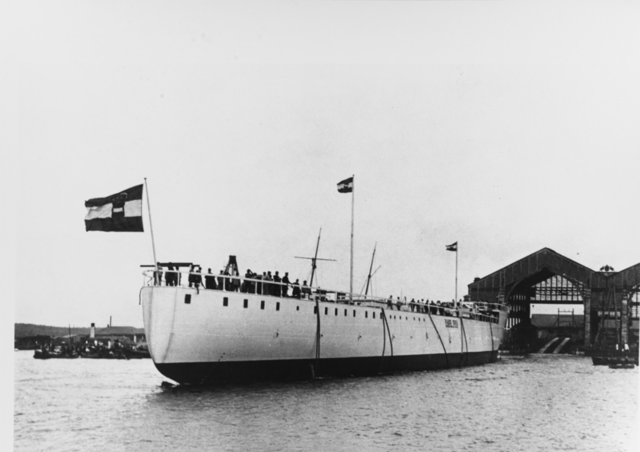
Launch of Admiral Spaun
Development
In 1904 the Austro-Hungarian Navy planned under Hermann F. von Spaun, its greatest extension yet, to Face potentially Italy or UK in the Mediterranean: No less than ten battleships, three armoured cruisers, six protected cruisers, eight torpedo vessels, and 68 torpedo craft. When Rudolf Montecuccoli replaced him as Marinekommandant, the plan was confirmed, with some adjustment, budget-wise.
Backed with the newly created Austrian Naval League in September 1904 and his post as Chief of the Naval Section of the War Ministry he was armed to have this plan implemented, more suitable for a great power. That was a radical shift from a coastal defence force to a blue water navy. In 1905, Austria was engaged de facto in a naval race with Italy which position was not clear yet. The same year, Montecuccoli started working on the new light cruiser design.
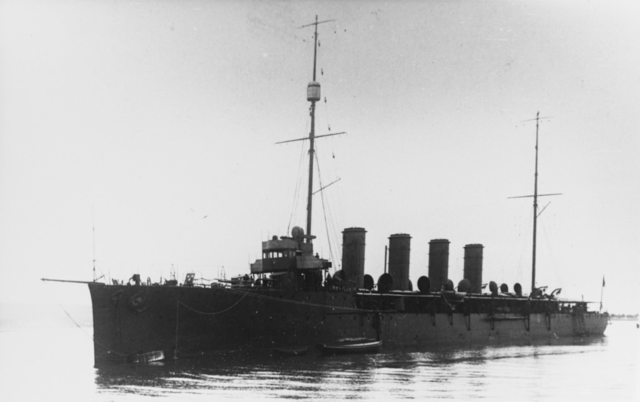
Admiral Spaun at anchor
His new naval plan indeed was revised and included four armoured cruisers and eight scout cruisers alongside with 18 destroyers and less TBs, but submarines. These scout cruisers were approved at the end of 1905, securing a naval law allocation of 121,000,000 Krone for the whole program. The first part however approved the construction of three Erzherzog Karl-class battleships, six destroyers and a single scout cruiser. Made to operate in the confined Adriatic Sea she was to be fast above all, disregarding range or protection.
Her core missions were to attack enemy shipping and communication lines while performing versatile hit-and-run missions. To reach the desired speed, Steam Turbines were the only way forward, a first for Austro-Hungarian war vessels.
Design of the Spaun
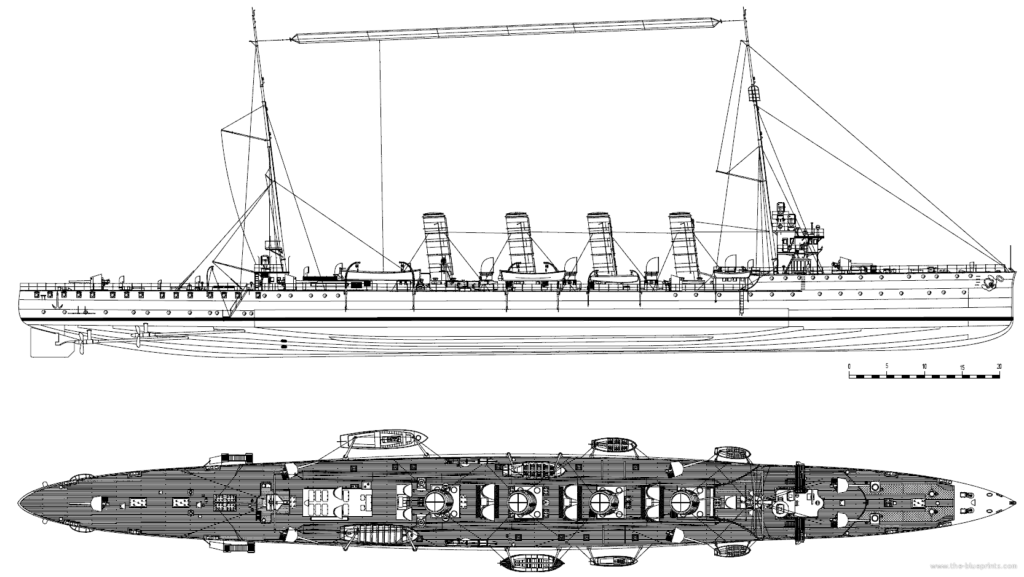
HD blueprint of the Admiral Spaun – origin unknown
The hull was 130.6 metres (428 ft 6 in) overall, 129.7 metres (425 ft 6 in) on the waterline and 125.2 metres (410 ft 9 in) between perpendiculars. She was 12.8 metres (42 ft 0 in) so her ratio was 1/10. Her draft was 5.3 metres (17 ft 5 in), deep load. She displaced 3,500 tonnes (3,400 long tons; 3,900 short tons), up to 4,000 tonnes (3,900 long tons; 4,400 short tons) fully loaded, combat ready.
Propulsion
She had no less than six Parsons steam turbines pated on four shafts. The Empire having no expertise in building turbines, they were imported. They were designed to provide 25,130–25,254 shp (18,739–18,832 kW). Steam was produced by 16 Yarrow water-tube boilers (presumably coal-fired). SMS Admiral Spaun top speed was 27 knots and she showed able to reach 27.07 knots (50.13 km/h; 31.15 mph) during her sea trials. To compared, the German Magdeburg class (1911) was only capable of 25 knots, like the British Bristol class. However she was to be compared to scout cruisers, and soon, the Italians would launch their very successful scout cruiser Quarto in August 1911, capable of 29 knots.
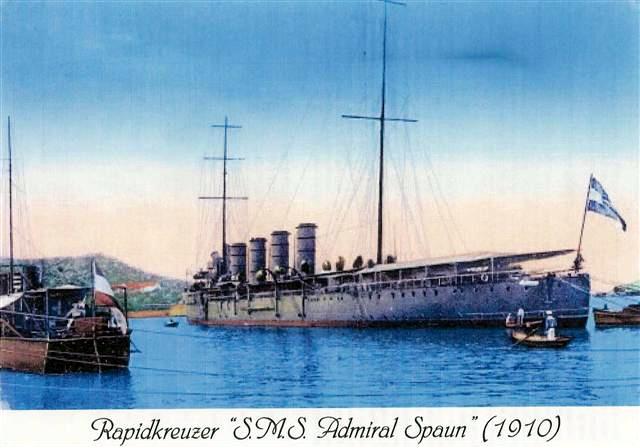
Postcard of the Admiral Spaun – Source: The borrowedfamily.com. Notice the “rapid cruiser” terminology.
Protection
Certaionly the weakest part of the design, as speed was the paramount factor. Spaun was protected at the waterline by a 60 mm (2.4 in) thick amidship armored belt. Main guns were protected by 40 mm (1.6 in) thick shields. The main deck was given just 20 mm (0.79 in). The conning tower was the strongest, relatively to the rest, with 60 mm (2.4 in) thick walls. Compared to the Quarto, this was inferior: The latter had a 100 mm thick Conning tower and 38 mm thick decks. In addition Quarto’s shallow draft (4 m) allowed her to avoid torpedoes and get very close to the coast.
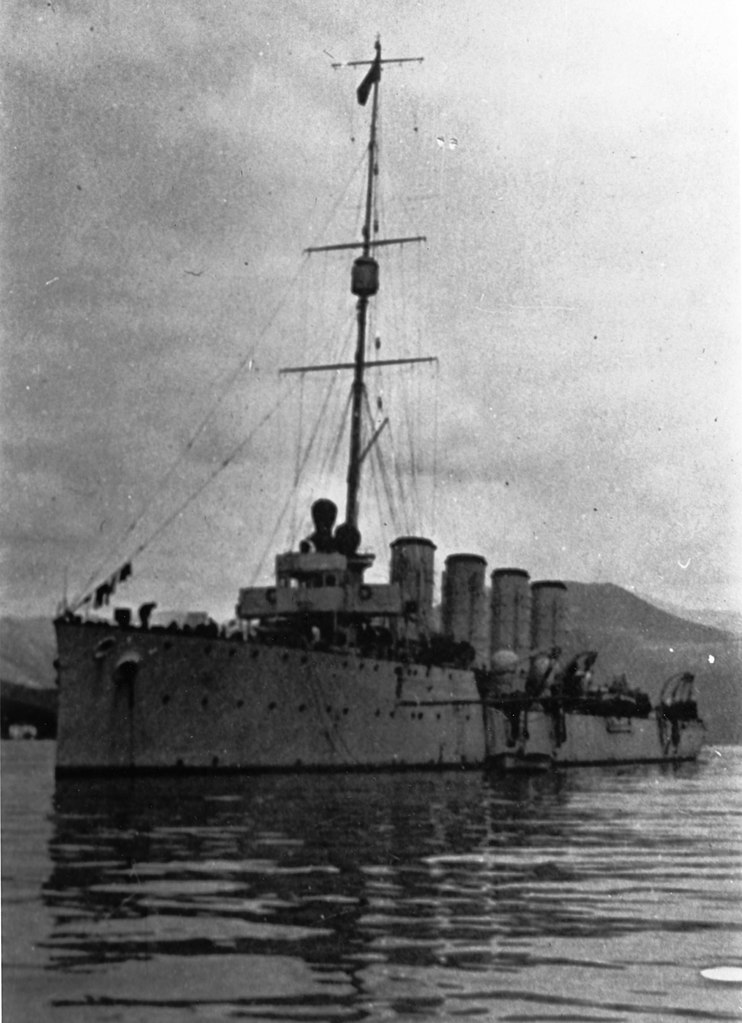
SMS Novara, circa 1915
Armament
The Admiral Spaun was given a relatively lighweight armament compared to most light cruisers of the time: She was given seven 50-caliber 10 cm (3.9 in) guns, all singles under masks. The first two were placed in tandem on the forecastle. Four were placed amidship, two on either side. The last was placed on the quarterdeck. They were good, standard Škoda models largely used in the Austro-Hungarian ships and exported. It was so good the Italians in 1924 copied it by OTO Melara as the 100/47. It was Quick-firing (8-10 rpm) with an horizontal sliding breech block, firing a 13.75 kilograms (30.3 lb) at about 880 meters per second (2,900 ft/s). Maximal range was 11 km (6.8 mi) at +14°. Still, that was twice lighter per volley compared to classic 6-in guns. The Italian Quarto had one less gun, but of 120 mm.
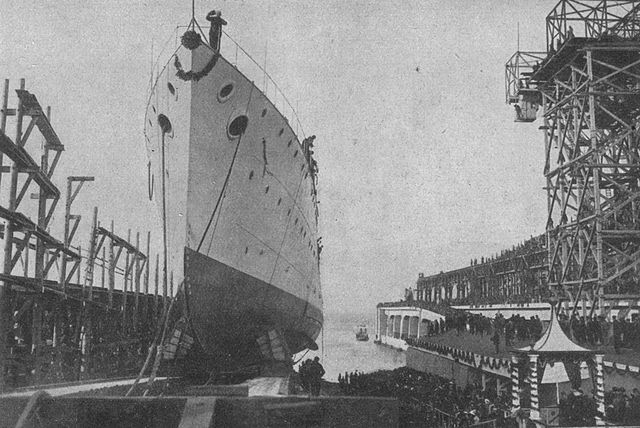
Launch of SMS Novara in 1913
Secondary armament comprised a single 47 mm (1.9 in) SFK L/44 gun and a single Škoda 7 cm (2.8 in)/50 K10 anti-aircraft gun.
She was armed also for close quarters at first by two 2 × 45 cm (18 in) torpedo tubes, replaced in 1916 by two twin banks of 53.3 cm (21 in) torpedo tubes.
The light armament meant the cruiser, despite having an advnce of two knots, could be out-ranges anyway by enemy cruisers. This led to plans to replaced at least the forecastle guns by a single 6-in (5.9 in) and another on the quarterdeckek. The war ended before it could be implemented.
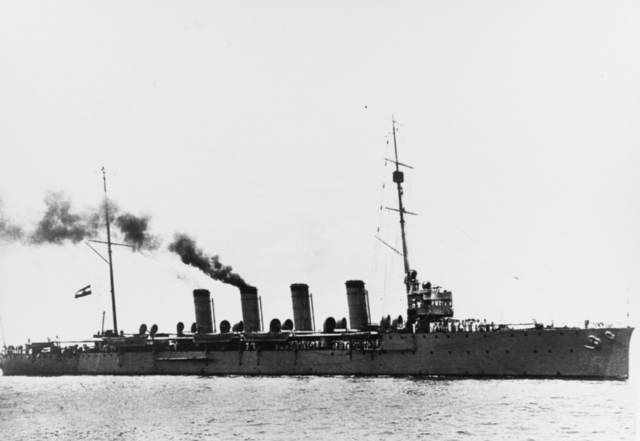
SMS Admiral Spaun
The Novara class (1913)
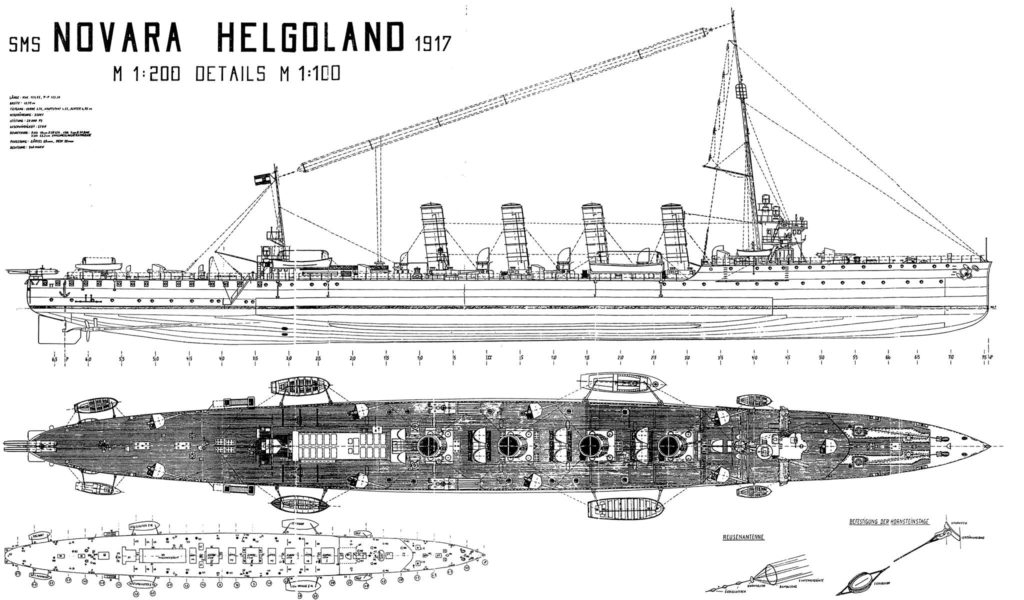
HD Blueprint of the Novara class, SMS Helgoland (Unknown origin)
The class was at first delayed for budgetary reasons, and the Army having the lion share of it. After being rebuffed once, Rudolf Montecuccoli, Marinekommandant from 1904 drafted a second memorandum to Emperor Franz Joseph I on 30 May 1910, more virulent, insisting on the recent acquisitions of the Regia Marina. This time his “urgent and quickest possible completion” program was granted. The plan included notably the Tegetthoff-class battleships, six destroyers, TBs and submarines but also three Novara-class cruisers.
The funds were obtained in December 1910. Dubbed “cruiser J, G and H” they were given credits lines of 30 million Kronen (10 million) each. Contracts were awarded to Cantiere Navale Triestino in Monfalcone and Ganz-Danubius in Fiume for the remainder two. It was understood from the beginning they were to be designed on the Admiral Spaun model, making a final superclass of four ships.
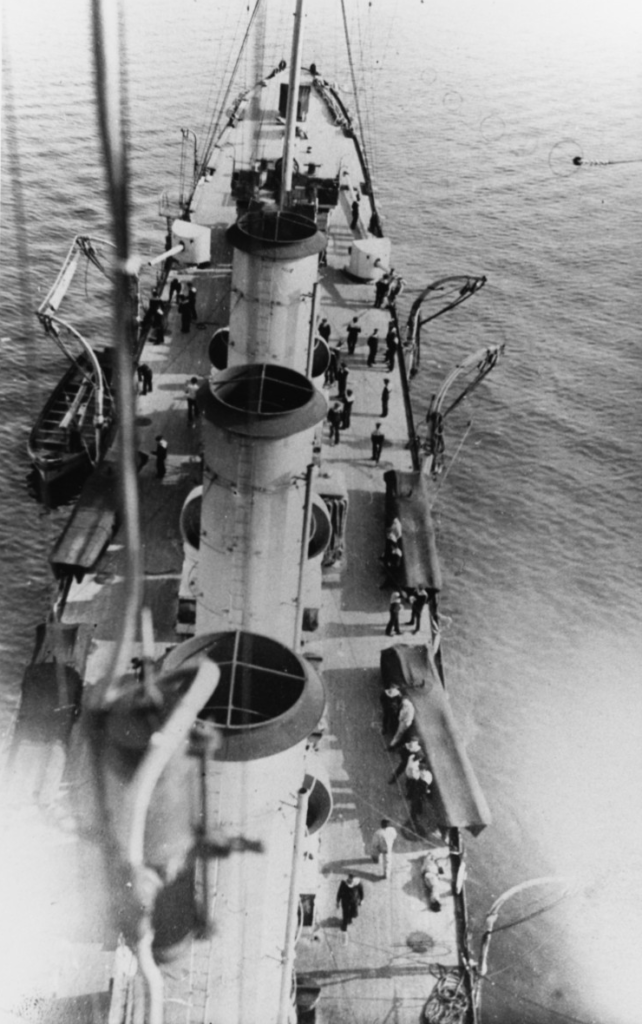
Admiral Spaun, overview of the deck
Specs were almost identical: The Novara were 130.64 meters (428 ft 7 in) long, 12.79 meters (42 ft 0 in) wide and had a 4.6 meters (15 ft 1 in) draft. Lenght was unchanged but the beam was reduced of a few centimeters. The powerplant was the same, with Parsons turbines and Yarrow boilers delivering 30,178 shp (22,504 kW). Range was 1,600 nautical miles (3,000 km; 1,800 mi) at 24 kn (44 km/h; 28 mph), good enough for the Adriatic. Displacement was 4,417 tonnes or 4,347 long tons or 4,869 short tons fully loaded. Armament, which was criticized by its weakness, was augmented on the Novara class, of nine 10 cm (3.9 in) guns, rather than seven. One was placed on the forecastle, two paired amidship behind the bridge, four were placed (two each side) amidships, and an extra pair on the quarterdeck. The other important change was the provision of two triple banks of 21-in (533 mm) torpedo tubes. Protection was unchanged.
The ships were authorized and laid down in September, October 1911 at Montfalcone and Trieste and named when launched: Saida was the city shelles during the Oriental Crisis of 1840, Helogoland was related to the Battle of Helgoland during the Second Schleswig War. The third, Novara, had to wait until the slopway was freed and laid down in December 1912. She was named after the Austrian victory at the Battle of Novara during the First Italian War of Independence. Launched in October and November 1912, and February 1913 for the Novara, they were completed on 1 August 1914 (Saida), 5 September 1914 (Helgoland) and 10 January 1915 for Novara. Why the last built gave its name to the whole serie remains an author’s oddity. Generally the class is encompassed as the Admiral Spaun.
Specifications |
|
| Dimensions | 96.88 x 11.73 x 4.24 m (317 x 34 x 13 ft) |
| Displacement | 3,500t (3,400 long tons) (4,000 t) FL |
| Crew | 327 |
| Propulsion | 4 shafts steam turbines, 16 boilers: 25,130–25,254 shp |
| Speed | 27 kn (50 km/h; 31 mph) |
| Armament | 7 × 100mm, 1 × 70 mm Skoda QF, 1x 47 mm AA, 2 × 450 mm TTs |
| Armor | Decks 20 mm, gunshields 30 mm, belt 60 mm, Conning tower 50 mm |

Author’s Illustration profile of the Admiral Spaun – 1/730
Sources, read more
https://en.wikipedia.org/wiki/SMS_Admiral_Spaun
http://dawlishchronicles.blogspot.fr/2014/08/the-battle-of-antivari-1914-heroic-last.html
https://en.wikipedia.org/wiki/Battle_of_Antivari
Conway’s all the world’s fighting ship 1860-1905 and 1906-1921
Career
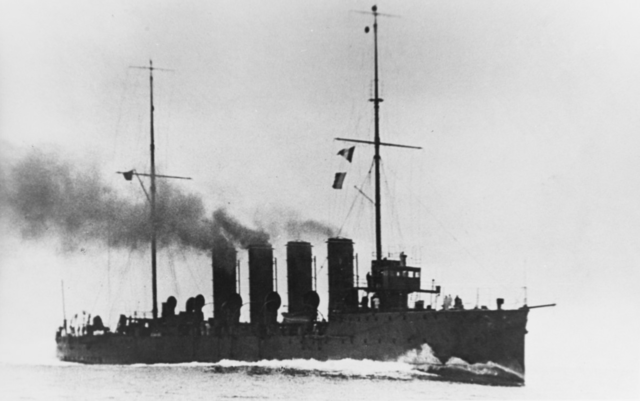
SMS Admiral Spaun underway
SMS Admiral Spaun
Just when the cruiser was commissioned the Italo-Turkish War erupted. In principle there was no state of war but neither any alliance between the two countries and tensions between remained high between the two nations. However later with the First Balkan War (and easy victory against the Ottoman Army by the coalition), Austro-Hungary found an agreement ground with Italy both opposed to the treaty about to give Serbian a port i the adriatic in November 1912. The flipside was also to prevent later the Empire to annex Serbia.
There was a first war scare about the alleged mistreatment of Austro-Hungarian consul in Prisrena, and troops were mobilized. Admiral Spaun and Aspern, which were anchored in Constantinople to protect Austrichian interests, were recalled and joined the Aegean squadron. The Treaty of London in May 1913 eventually diffused the crisis, the fleet was demobilized, but Serbia was granted an access to the adriatic.
In June 1914, the Archduke and his wife were carried to Bosnia-Herzegovina on the SMS Viribus Unitis, shot dead during his good will tour in Sarajevo. After reading the news, the Marinekommandant Anton Haus sailed from Pola with Admiral Spaun, Tegetthoff, and TBs to join Viribus Unitis and carry them back wtih the Archduke body. Afterwards started the July Crisis, which only resolved on July 28, when the Empire declare war to Serbia. In August with the war breaking off and Italy staying out of it, Austria-Hungary was dashed in its hopes of using the Regia Marina’s coal stored in Italian ports to access the Mediterranean. The entire fleet was confined to Pola, almost for the remainder of the war.
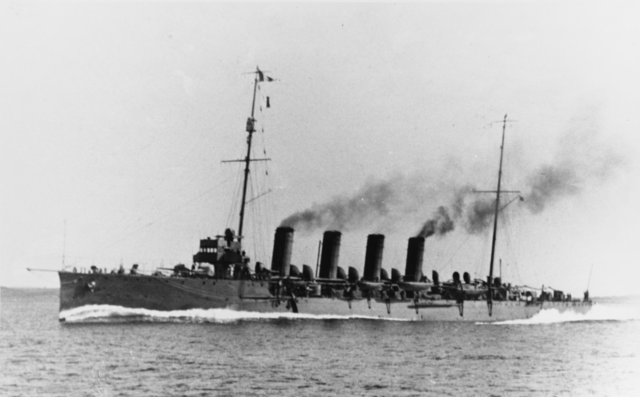
Admiral Spaun underway, during the war
However the other allied Central Empire, Germany, asked the fleet to support the their Mediterranean Division, made of the Goeben and Breslau and based at Dar-es-Salaam, trapped in the Mediterranean, to get back home. They attempted to break out of Messina but the allies gather their ships to trap them here. Rapidly the fleet was mobilized and sent in support, with the three Radetzkys and three Tegetthoffs, the armoured cruiser Sankt Georg, six destroyers, and 13 torpedo boats, led by the Admiral Spaun. They sailed to Brindisi, but the German ships has been luring attention there, Admiral Souchon instead rounded the southern tip of Greece headed for the Dardanelles, and later Constantinople where they will integrate the Turkish fleet. The Austro-Hungarian went home before even reaching its destination.
Next, French Admiral Augustin Boué de Lapeyrère started a campaign against Austro-Hungarian shipping and while heading for Montenegro, the Battle of Antivari happened. The result of it was the Austro-Hungarian cruiser SMS Zenta was sunk. The following inactivity of the fleet was forced by the presence of mines and the always present French Navy threat. In addition the fleet was kept in case italy decided to join the war on the entent side (which eventually happened in 1915). Apparently Admiral Spaun’s troublesome propulsion system was apparently worse than the Novara-class and she stayed mostl inactive instead of using her speed to raid the Adriatic.
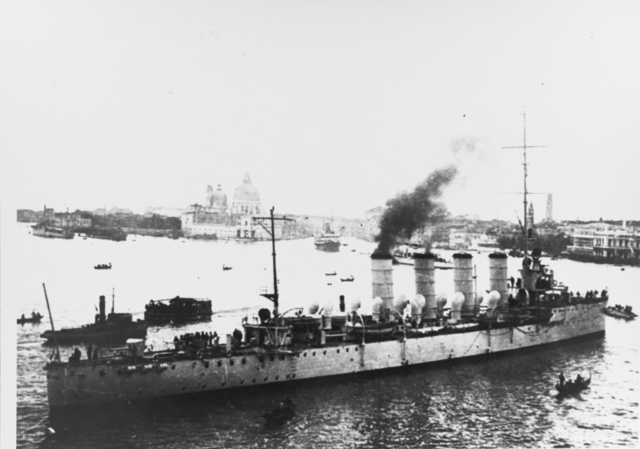
SMS Admiral Spaun in Venice in 1919
However she did participate in the Bombardment of Ancona. When Italy was about to join the entente in April, communication came from Germany that Italy renounced their alliance, communicated to Vienna. This left time to the Asutro-Hungrian Navy to launch a raid against Italian shipping. On May, 23, four hours after the declaration of war, the fleet started to raid the Italian coast. This was made by the battleships, under cover by a wing constituted of Admiral Spaun, Saida, Helgoland, and Szigetvár, in faction to spot and prevent any Italian reinforcement. Later she was shelling the port of Termoli and next Campomarino, disrupting a large railway hub, freight yard and station. The bombardment of Ancona was a success, with four steamers sank or damaged and one destroyer sunk (Turbine). Meanwhile, seaplaned raided Venice and Ancona.
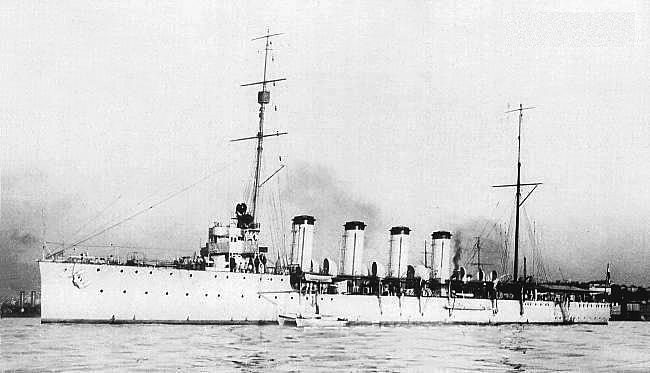
Despite her machinery problems, Admiral Spaun made other missions, mainly in the northern Adriatic. She usually protected minelayng missions. She also was sent in reinforcement to her near-sister-ship Helogoland raiding Durazzo in the southern Adriatic on 28-29 December 1915. Spaun underwent a refit in 1916 with new AA guns and new torpedo tubes. In december 1917, Admiral Spaun and Árpád (Habsburg class) were sent to renforce Trieste in order to shell Italian artillery positions at the mouth of the Piave River, but it was recalled because of bad weather.
After Miklós Horthy took command of the fleet, the Otranto raid became his new priority, after quelling the reasons of the mutiny at Cattaro. In addition to the four Tegetthoff class BSs, and four Tátra-class the effective “battlecruisers” of the navy, the four Novara, were first line. This started in two batches, on 8 June 1918 and in the evening of 9 June. However that day, while still en route, at reduced speed becasuse of engines overheating by night to Otranto (the project was to arrive at dawn, falling on the entente fleet), SMS Szent István and Tegetthoff were attacked by Italian MAS and Szent István was torpedoes and sank. Horthy called back the attack and the fleet returned to Pola.
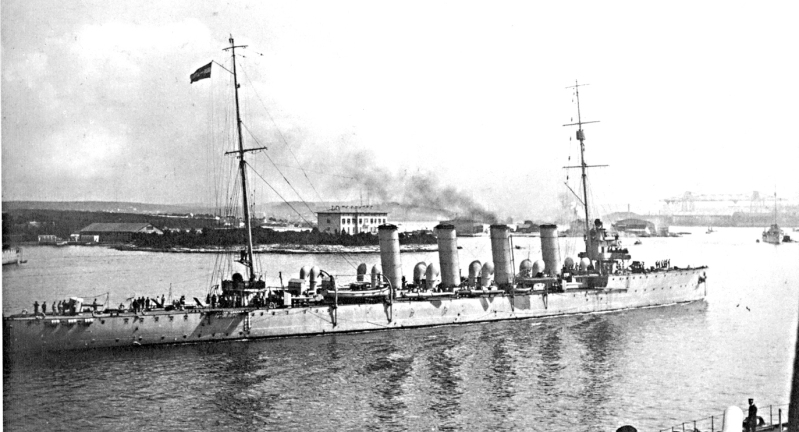
After capitulation, the fleet was mostly ceded to the State of Slovenes, Croats and Serbs, but Italy refused the clause and soon took over Trieste, Pola, and Fiume. Viribus Unitis (Dalmacija) was sank by an italian frogman, and Admiral Spaun sailed in Venice by March 1919, as part of an Italian victory parade. The Treaty of Saint-Germain-en-Laye re-attributed the ship to Great Britain, which eventually sold it to an Italian shipbreaker in 1920.
SMS Novara, Said and Helgoland in action
Prewar
Saida was commissioned first into the Austro-Hungarian Navy, on 1 August 1914, four days the war was declared on Serbia. She was designated flotilla leader for the First Torpedo Flotilla (Captain Heinrich Seitz), including the six Tátra-class destroyers, six Huszár-class destroyers, ten to eighteen torpedo boats supported by the depot ships Gäa and Steamer IV. This spearpoint of the K.u.K. navy, the First Torpedo Flotilla, was based at Sebenico in August 1914.
1914-15 operations
SMS Helgoland was commissioned on 5 September 1914 and joined Saida. Following the entente declaration of war on Austria-Hungary, 11-12 August French Admiral Augustin Boué de Lapeyrère close off Austro-Hungarian shipping and the Adriatic Sea , transformed virtually into a large ships POW sea. Lapeyrère attacked Austro-Hungarian ships blockading Montenegro first, the Battle of Antivari, and the Strait of Otranto was made into an effective blocking line, preve,ting any sortie in the Mediterranean.
Saida and Helgoland came too late to participate in the support fleet activated to cover the battlecruiser Goeben and light cruiser Breslau. They stayed in Sebenico, inactive under orders of Admiral Anton Haus. However this attentism earned sharp criticism from the Austro-Hungarian Army, Foreign Ministry and the Navy itself. The crews in particular were itching for a fight. This left plenty of time for the entente navies to reorganize a solid blockade system at the Strait of Otranto. But this presence was also constraining the entente fleets here, instead of being used on other front, like in the Galipoli campaign later. Because of their speed however, the Novara class, soon reinforced by the class namesake ship, SMS Novara in 1915, and renforced by the Admiral Spaun, made a fast striking force, potentially the most active in the fleet.
1915 operations
The inactivity of the fleet (only partial, as the Novara class were the only ship to make raids in the adriatic during this time) was also criticized by Germany, pressuring Austria-Hungary to assist the Ottomans, hard fighting the entente in Gallipoli. SMS Novara most daring feat was on 2 May 1915, towing the German U-boat UB-8 from Pola out of the Adriatic Sea and back while evading French patrols, although she had to cut the two when spotted off Cephalonia.
The entry of Italy into the war on the side of the Entente provked an early hours massive operation from the K.u.K. Navy, and the three Novara class and Spaun acted as cover for the battleship shelling Ancona and other objectives on the coast, on 23 May 1915. However before departing, SMS Novara made a raid with a destroyer and two torpedo boats, on Porto Corsini near Ravenna. Counter-battery fire by coastal defense made six victims on the Novara. Meanwhile Helgoland and two destroyers sank the Italian destroyer Turbine. The sortie, collectively called nowadays the “bombardment of Ancona” was one of the rare success of the Navy.
They also raided the coast of Montenegro, without opposition. During the summer of 1915, Helgoland and four destroyers raided the island of Pelagosa. Later in the year, the Novara squadron was hard at work on a weekly basis to sink and damage merchant ships supplying Allied forces in Serbia and Montenegro. During the night of 22 November 1915, Saida and Helgoland plus the 1st Torpedo Division raided the Albanian coast, sinking two Italian transports. Helgoland, Noara and the squadron was later relocated in Cattaro on 29 November.
All along December, they rampage the coast, sinking many transports, capturing the French submarine Fresnel, sinking the French submarine Monge and attacking Durazzo. While during the raid two Austro-Hungarian destroyers were lost to mines, the Novara, Admiral Spaun, and coastal defense ship Budapest were sent in reinforcement.
1916 operations
This year was still active for the cruisers: The French submarine Foucault on 13 January 1916 torpedoed but apparently failed to sink her, despite Italian reports. None of these fast cruisers was ever sank during the war, despite their very active life. On 29 January 1916 Novara and two destroyers raided Durrazo. Both destroyers collided and had to be sent back, but the Novara went on to complete the raid, encountering before arrival Italian protected cruiser Puglia and a French destroyer.
After a short duel, Novara sailed back to port. On the night of 31 May 1916 this was the turn of Helgoland, attacked drifters blockading the Strait of Otranto, sinking one. Soon after Miklós Horthy launched on July, 9, another raid, and Novara sank two drifters, damaged two, and captured nine British sailors, which was a gift for propaganda. Meanwhile Saida’s troubesome turbines had her missing most of the actions, just like Admiral Spaun. Helgoland and Novara therefore took the bulk of these actions.
1917 Operations: The battle of Oranto
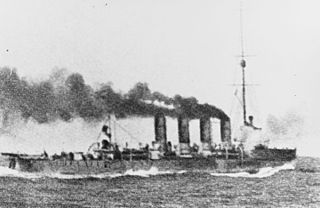 Horthy’s raid of February 1917 on the Otranto barrage mobilized all three Novara cruisers, which were modified to resemble destroyers. In addition they were comprehensively overhauled: Boilers and turbines revised and cleaned up, tested, extra AA gun on all ships; After destroyers has been assessing defences on the coast of Albania, on 13 May, Rear Admiral Alexander Hansa launched the operation. The three cruisers were preceded by the destroyers, making a diversionary attack.
Horthy’s raid of February 1917 on the Otranto barrage mobilized all three Novara cruisers, which were modified to resemble destroyers. In addition they were comprehensively overhauled: Boilers and turbines revised and cleaned up, tested, extra AA gun on all ships; After destroyers has been assessing defences on the coast of Albania, on 13 May, Rear Admiral Alexander Hansa launched the operation. The three cruisers were preceded by the destroyers, making a diversionary attack.
They slipped through a first line of drifters and fell on 15 May on 47 drifters of the Otranto barrage, sinking 14 and damaging 4. On they way back they were intercepted by four French destroyers led by the Carlo Mirabello, repelled by the heavier artillery of both cruisers and later the British protected cruisers, Bristol and Dartmouth and four Italian destroyers.
This was the battle of Otranto.
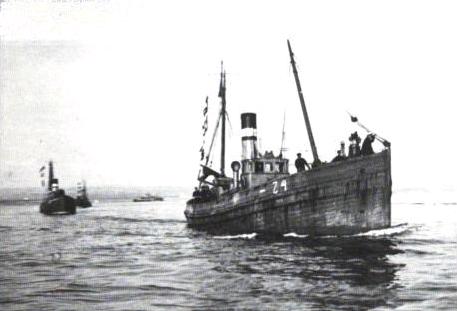
British drifters at Otranto.
Fire was exchanged at 10,600 yards (9,700 m), smoke screens laid up, while the Novara class retired. The armored cruiser Sankt Georg sortied along with two destroyers and four torpedo boats as a reinforcement. But before they arrive, the Austro-Hungarian cruisers swept out of their smoke at much closer range, engaging the British cruisers, at 4,900 yards (4,500 m).
They took several hits but inflicting damage and retired again. However Novara was badly damaged, boilers destroyed, and was left dead in the water with admiral Horthy on board, wounded. Saida took her in tow when three Italian destroyers fell upon them. Fortunately, Sankt Georg just arrived and repelled them, covering the towing operation back to Cattaro. Before they arrived, Budapest and three more torpedo boats were sent to provide an additional escort. This was a tremendous sucsess and Horthy’s prestige and all times high. To give an indication of how firce this was, SMS Helgoland fired 1,052 shells during the battle.
1918 operations and aftermath
Cattaro Mutiny
While the Cattaro mutiny took place in the large ships of the fleet, crews of Novara and Helgoland resisted the mutiny and even prepared their terpoedo tubes in case… This triggered as a response Sankt Georg’s gunners aiming their 24 cm guns at the Helgoland and later Novara when commander Johannes, Prinz von Liechtenstein refused to let a rebel boarding party in. He would later confer with Erich von Heyssler (Helgoland) about the best way to go, whereas on the Sankt Georg and Kaiser Karl VI red flags were raised. The following day, the rebels lost steam after Kronprinz Erzherzog Rudolf ws fired upon by loyalist coastal batteries. The two Novara class and lighter TBs and destroyers were soon joined by Erzherzog Karl-class battleships and quelled the rebellion for good.
Attempted second great raid on Otranto (8 June 1918)
The new C-in-C of the Navy, admiral Horthy launched the project of a large raid on the Otranto barrage to motivate crews, and in addition to the brand new Tegetthoff class dreadnoughts, all three ships of the Novara class and the Admiral Spaun preceded the line. But after Szent István was torpedoed by Italian MAS the whole fleet has to back down and was sent home, for good. There was no longer any attempt at sea until the end of the war.
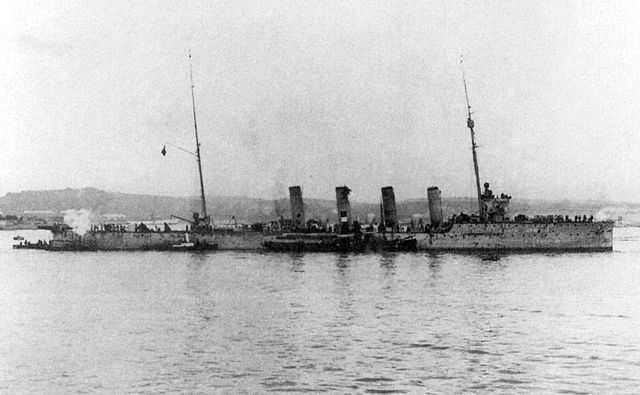
SMS Helgoland after the war
Fate of the Novara class ships
After Austro-Hungarian capitulation the State of Slovenes, Croats and Serbs was created and asked to receive the lion share of the Navy, mainly helping to maintain the fleet in Pola in order. This was also a preferred option to cede the navy to this new neutral state rather than to cede it to the allies, seen as an humiliation (like for Germany). However the Entente feared (in particular the Italians) the consequences and a new treaty of Saint-Germain-en-Laye in 1920. SMS Novara was attributed to France (and became Thionville, later a schoolship), while Helgoland and Saida were cedede to Italy and renamed Venezia and Brindidi respectively. They received new AA, but were mostly kept as guardships, Venezia at La Spezia and Brindisi at Bizerte before joinin the scout cruiser division (Grupo esploratori), flagship of Rear Admiral Massimiliano Lovatelli, after some modifications. She had a very active life until written off in 1937, like Venezia.

 Latest Facebook Entry -
Latest Facebook Entry -  X(Tweeter) Naval Encyclopedia's deck archive
X(Tweeter) Naval Encyclopedia's deck archive Instagram (@navalencyc)
Instagram (@navalencyc)





 French Navy
French Navy Royal Navy
Royal Navy Russian Navy
Russian Navy Armada Espanola
Armada Espanola Austrian Navy
Austrian Navy K.u.K. Kriegsmarine
K.u.K. Kriegsmarine Dansk Marine
Dansk Marine Nautiko Hellenon
Nautiko Hellenon Koninklije Marine 1870
Koninklije Marine 1870 Marinha do Brasil
Marinha do Brasil Osmanlı Donanması
Osmanlı Donanması Marina Do Peru
Marina Do Peru Marinha do Portugal
Marinha do Portugal Regia Marina 1870
Regia Marina 1870 Nihhon Kaigun 1870
Nihhon Kaigun 1870 Preußische Marine 1870
Preußische Marine 1870 Russkiy Flot 1870
Russkiy Flot 1870 Svenska marinen
Svenska marinen Søværnet
Søværnet Union Navy
Union Navy Confederate Navy
Confederate Navy Armada de Argentina
Armada de Argentina Imperial Chinese Navy
Imperial Chinese Navy Marinha do Portugal
Marinha do Portugal Mexico
Mexico Kaiserliche Marine
Kaiserliche Marine 1898 US Navy
1898 US Navy Sovietskiy Flot
Sovietskiy Flot Royal Canadian Navy
Royal Canadian Navy Royal Australian Navy
Royal Australian Navy RNZN Fleet
RNZN Fleet Chinese Navy 1937
Chinese Navy 1937 Kriegsmarine
Kriegsmarine Chilean Navy
Chilean Navy Danish Navy
Danish Navy Finnish Navy
Finnish Navy Hellenic Navy
Hellenic Navy Polish Navy
Polish Navy Romanian Navy
Romanian Navy Turkish Navy
Turkish Navy Royal Yugoslav Navy
Royal Yugoslav Navy Royal Thai Navy
Royal Thai Navy Minor Navies
Minor Navies Albania
Albania Austria
Austria Belgium
Belgium Columbia
Columbia Costa Rica
Costa Rica Cuba
Cuba Czechoslovakia
Czechoslovakia Dominican Republic
Dominican Republic Haiti
Haiti Hungary
Hungary Honduras
Honduras Estonia
Estonia Iceland
Iceland Eire
Eire Equador
Equador Iran
Iran Iraq
Iraq Latvia
Latvia Liberia
Liberia Lithuania
Lithuania Mandchukuo
Mandchukuo Morocco
Morocco Nicaragua
Nicaragua Persia
Persia San Salvador
San Salvador Sarawak
Sarawak Uruguay
Uruguay Venezuela
Venezuela Zanzibar
Zanzibar Warsaw Pact Navies
Warsaw Pact Navies Bulgaria
Bulgaria Hungary
Hungary

 Bundesmarine
Bundesmarine Dutch Navy
Dutch Navy Hellenic Navy
Hellenic Navy Marina Militare
Marina Militare Yugoslav Navy
Yugoslav Navy Chinese Navy
Chinese Navy Indian Navy
Indian Navy Indonesian Navy
Indonesian Navy JMSDF
JMSDF North Korean Navy
North Korean Navy Pakistani Navy
Pakistani Navy Philippines Navy
Philippines Navy ROKN
ROKN Rep. of Singapore Navy
Rep. of Singapore Navy Taiwanese Navy
Taiwanese Navy IDF Navy
IDF Navy Saudi Navy
Saudi Navy Royal New Zealand Navy
Royal New Zealand Navy Egyptian Navy
Egyptian Navy South African Navy
South African Navy






























 Ukrainian Navy
Ukrainian Navy dbodesign
dbodesign